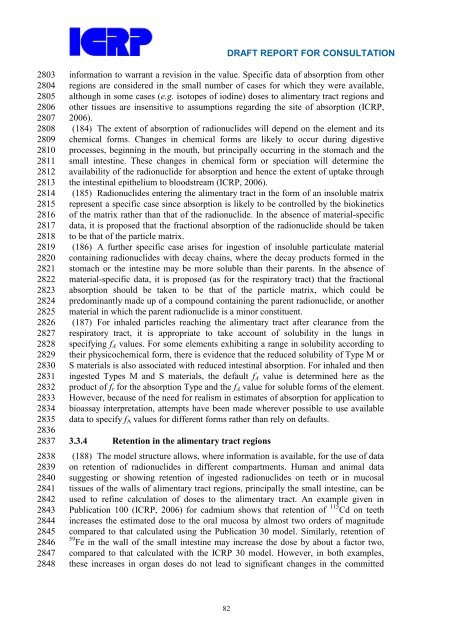Occupational Intakes of Radionuclides Part 1 - ICRP
Occupational Intakes of Radionuclides Part 1 - ICRP
Occupational Intakes of Radionuclides Part 1 - ICRP
You also want an ePaper? Increase the reach of your titles
YUMPU automatically turns print PDFs into web optimized ePapers that Google loves.
2803<br />
2804<br />
2805<br />
2806<br />
2807<br />
2808<br />
2809<br />
2810<br />
2811<br />
2812<br />
2813<br />
2814<br />
2815<br />
2816<br />
2817<br />
2818<br />
2819<br />
2820<br />
2821<br />
2822<br />
2823<br />
2824<br />
2825<br />
2826<br />
2827<br />
2828<br />
2829<br />
2830<br />
2831<br />
2832<br />
2833<br />
2834<br />
2835<br />
2836<br />
2837<br />
2838<br />
2839<br />
2840<br />
2841<br />
2842<br />
2843<br />
2844<br />
2845<br />
2846<br />
2847<br />
2848<br />
DRAFT REPORT FOR CONSULTATION<br />
information to warrant a revision in the value. Specific data <strong>of</strong> absorption from other<br />
regions are considered in the small number <strong>of</strong> cases for which they were available,<br />
although in some cases (e.g. isotopes <strong>of</strong> iodine) doses to alimentary tract regions and<br />
other tissues are insensitive to assumptions regarding the site <strong>of</strong> absorption (<strong>ICRP</strong>,<br />
2006).<br />
(184) The extent <strong>of</strong> absorption <strong>of</strong> radionuclides will depend on the element and its<br />
chemical forms. Changes in chemical forms are likely to occur during digestive<br />
processes, beginning in the mouth, but principally occurring in the stomach and the<br />
small intestine. These changes in chemical form or speciation will determine the<br />
availability <strong>of</strong> the radionuclide for absorption and hence the extent <strong>of</strong> uptake through<br />
the intestinal epithelium to bloodstream (<strong>ICRP</strong>, 2006).<br />
(185) <strong>Radionuclides</strong> entering the alimentary tract in the form <strong>of</strong> an insoluble matrix<br />
represent a specific case since absorption is likely to be controlled by the biokinetics<br />
<strong>of</strong> the matrix rather than that <strong>of</strong> the radionuclide. In the absence <strong>of</strong> material-specific<br />
data, it is proposed that the fractional absorption <strong>of</strong> the radionuclide should be taken<br />
to be that <strong>of</strong> the particle matrix.<br />
(186) A further specific case arises for ingestion <strong>of</strong> insoluble particulate material<br />
containing radionuclides with decay chains, where the decay products formed in the<br />
stomach or the intestine may be more soluble than their parents. In the absence <strong>of</strong><br />
material-specific data, it is proposed (as for the respiratory tract) that the fractional<br />
absorption should be taken to be that <strong>of</strong> the particle matrix, which could be<br />
predominantly made up <strong>of</strong> a compound containing the parent radionuclide, or another<br />
material in which the parent radionuclide is a minor constituent.<br />
(187) For inhaled particles reaching the alimentary tract after clearance from the<br />
respiratory tract, it is appropriate to take account <strong>of</strong> solubility in the lungs in<br />
specifying fA values. For some elements exhibiting a range in solubility according to<br />
their physicochemical form, there is evidence that the reduced solubility <strong>of</strong> Type M or<br />
S materials is also associated with reduced intestinal absorption. For inhaled and then<br />
ingested Types M and S materials, the default fA value is determined here as the<br />
product <strong>of</strong> fr for the absorption Type and the fA value for soluble forms <strong>of</strong> the element.<br />
However, because <strong>of</strong> the need for realism in estimates <strong>of</strong> absorption for application to<br />
bioassay interpretation, attempts have been made wherever possible to use available<br />
data to specify fA values for different forms rather than rely on defaults.<br />
3.3.4 Retention in the alimentary tract regions<br />
(188) The model structure allows, where information is available, for the use <strong>of</strong> data<br />
on retention <strong>of</strong> radionuclides in different compartments. Human and animal data<br />
suggesting or showing retention <strong>of</strong> ingested radionuclides on teeth or in mucosal<br />
tissues <strong>of</strong> the walls <strong>of</strong> alimentary tract regions, principally the small intestine, can be<br />
used to refine calculation <strong>of</strong> doses to the alimentary tract. An example given in<br />
Publication 100 (<strong>ICRP</strong>, 2006) for cadmium shows that retention <strong>of</strong> 115 Cd on teeth<br />
increases the estimated dose to the oral mucosa by almost two orders <strong>of</strong> magnitude<br />
compared to that calculated using the Publication 30 model. Similarly, retention <strong>of</strong><br />
59<br />
Fe in the wall <strong>of</strong> the small intestine may increase the dose by about a factor two,<br />
compared to that calculated with the <strong>ICRP</strong> 30 model. However, in both examples,<br />
these increases in organ doses do not lead to significant changes in the committed<br />
82

















